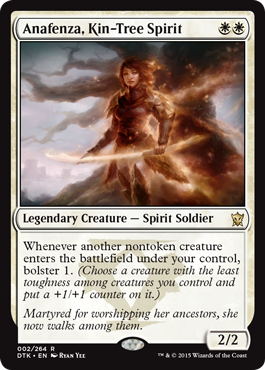Magic the Gathering’s designers and writers face some fairly unique narrative challenges every set they release. They have to tell a story almost entirely through the art, flavor text, names, and mechanics of trading cards. They have no guarantee that the average player is going to look at any supplementary writing and they have little control over which cards any given player is going to see. Every booster pack of 15 cards contains a small vignette and that vignette needs to be compelling enough to motivate a player to buy another. Yet, in spite of these constraints, MTG consistently manages to tell stories that have moved me. For me, the key to strong stories in MTG is in tonal shifts and juxtaposition.
The current MTG block, Khans of Tarkir, tells the story of the world of Tarkir and its journey from a dragon-less land full of warring clans ruled by mortal Khans (think Genghis Khan) to a dragon-controlled land full of warring clans ruled by dragons. This transition from no dragons to dragon-infested is made via a time travel story. The first set occurs in the present day in a world where dragons have been eradicated. The second set, Fate Reforged, takes place 1000 years in Tarkir’s past and it shows how one small change to the past can change everything, Back to the Future style. The third set, Dragons of Tarkir, takes place in an alternate future where the dragons have taken over and subjugated all of the clans that used to be ruled based on their own unique customs and rituals. This story is fairly straightforward to understand, but the way that it is told via mechanics and cards is worth studying.
I want to break down one cycle of cards that exemplifies the type of tonal shifts and juxtaposition that MTG excels at: the Khan cycle. Each of the clans in the first set of the block (the Abzan, Jeskai, Sultai, Mardu, and Temur clans) is ruled by a Khan and those Khans also exist in an altered form in the third set. In the first set, each of the Khans is represented by a powerful mythic-rare card with abilities that clearly align with their clan’s core values. However, they do not use their clan’s central mechanic. For example, the ruler of the Abzan clan is a human woman named Anafenza. Her card in Khans of Tarkir is a 4/4 creature for 3 mana that places a +1/+1 counter on another tapped creature whenever she attacks and exiles creatures that would go in your opponent’s graveyard. This card is already very efficient as a 4/4 for 3 mana, but it also plays very well with the Abzan mechanic, Outlast. Outlast requires you to tap your creatures to give them +1/+1 counters, effectively disabling your creature for one turn to power it up forever. So Anafenza can power up creatures that are Outlasting and spread +1/+1 counters to creatures that are attacking (+1/+1 counters are a big Abzan theme as well). Anafenza exiles creatures from your opponent’s graveyard because she is dogmatically devoted to her ancestors and the dead. She prevents opponents from defiling their dead via necromancy or other types of black magic. Her card and the cards of the other Khans manage to be great leaders of their fellow kinsman, while not being reduced to using their clan’s common mechanic.

In Dragons of Tarkir, each of the clans have been destroyed or co-opted by a draconic leader; yet, the former Khans still exist. But, oh, how the mighty have fallen. Two of the former Khans are dead, two of them are foot soldiers, and one of them has ascended to become a Planeswalker (a person who can literally walk between the different worlds of the MTG multiverse). While each of the Khans used to be above their fellow clan members, in Dragons of Tarkir each of them use the draconic abilities that took over their clans. For example, Anafenza is a ghost in Dragons of Tarkir because her reverence for the dead violated the beliefs of the draconic brood that took over her people. While she used to be a 4/4 for 3 mana across 3 colors, she is now a 2/2 for 2 white mana. While she used to boost creatures by attacking, she now utilizes the mechanic Bolster to distribute +1/+1 counters whenever a non-token creature enters the battlefield. And that’s all she does! She went from a powerful and multifaceted creature capable of bending whole games to a nice, role-playing ghost. Somehow her fall isn’t even the biggest! One of the other former Khans is a zombie and one shrunk from a rampaging mauler to a bell-boy. Even Narset, the Khan who became a Planeswalker, utilizes a draconic ability and takes orders from a dragon (taking orders from a dragon is a downgrade in status despite how cool it sounds).
While the actual plot of Khans of Tarkir block is a bit hard to follow just from reading cards, the meta-narrative of the Khans falling to disrepair is clear and moving. MTG is outstanding at showing broad, sweeping changes throughout a world and even a person. By juxtaposing two cards that represent the same character, MTG is capable of effectively communicating changes that could take chapters of exposition and character building.
Log in to comment